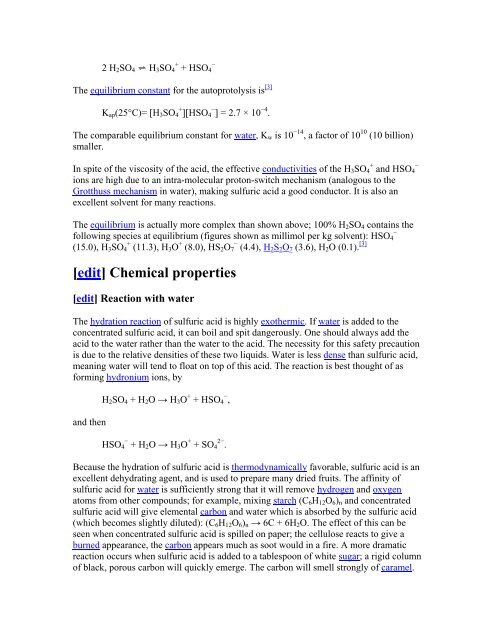Sulfuric acid
Sulfuric acid
Sulfuric acid
- No tags were found...
Create successful ePaper yourself
Turn your PDF publications into a flip-book with our unique Google optimized e-Paper software.
2 H 2 SO 4 ⇌ H 3 SO 4 + + HSO 4−The equilibrium constant for the autoprotolysis is [3]K ap (25°C)= [H 3 SO 4 + ][HSO 4 − ] = 2.7 × 10 −4 .The comparable equilibrium constant for water, K w is 10 −14 , a factor of 10 10 (10 billion)smaller.In spite of the viscosity of the <strong>acid</strong>, the effective conductivities of the H 3 SO 4 + and HSO 4−ions are high due to an intra-molecular proton-switch mechanism (analogous to theGrotthuss mechanism in water), making sulfuric <strong>acid</strong> a good conductor. It is also anexcellent solvent for many reactions.The equilibrium is actually more complex than shown above; 100% H 2 SO 4 contains thefollowing species at equilibrium (figures shown as millimol per kg solvent): HSO 4−(15.0), H 3 SO 4 + (11.3), H 3 O + (8.0), HS 2 O 7 − (4.4), H 2 S 2 O 7 (3.6), H 2 O (0.1). [3][edit] Chemical properties[edit] Reaction with waterThe hydration reaction of sulfuric <strong>acid</strong> is highly exothermic. If water is added to theconcentrated sulfuric <strong>acid</strong>, it can boil and spit dangerously. One should always add the<strong>acid</strong> to the water rather than the water to the <strong>acid</strong>. The necessity for this safety precautionis due to the relative densities of these two liquids. Water is less dense than sulfuric <strong>acid</strong>,meaning water will tend to float on top of this <strong>acid</strong>. The reaction is best thought of asforming hydronium ions, byand thenH 2 SO 4 + H 2 O → H 3 O + + HSO 4 − ,HSO 4 − + H 2 O → H 3 O + + SO 4 2− .Because the hydration of sulfuric <strong>acid</strong> is thermodynamically favorable, sulfuric <strong>acid</strong> is anexcellent dehydrating agent, and is used to prepare many dried fruits. The affinity ofsulfuric <strong>acid</strong> for water is sufficiently strong that it will remove hydrogen and oxygenatoms from other compounds; for example, mixing starch (C 6 H 12 O 6 ) n and concentratedsulfuric <strong>acid</strong> will give elemental carbon and water which is absorbed by the sulfuric <strong>acid</strong>(which becomes slightly diluted): (C 6 H 12 O 6 ) n → 6C + 6H 2 O. The effect of this can beseen when concentrated sulfuric <strong>acid</strong> is spilled on paper; the cellulose reacts to give aburned appearance, the carbon appears much as soot would in a fire. A more dramaticreaction occurs when sulfuric <strong>acid</strong> is added to a tablespoon of white sugar; a rigid columnof black, porous carbon will quickly emerge. The carbon will smell strongly of caramel.
















